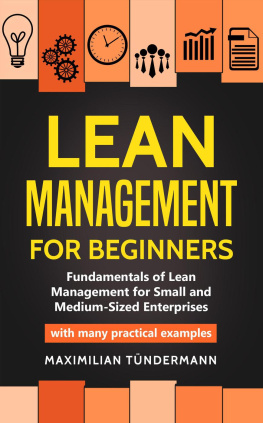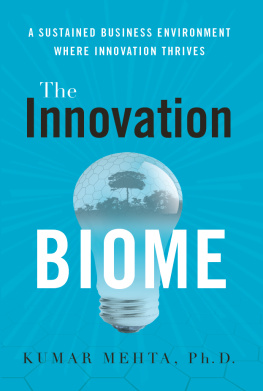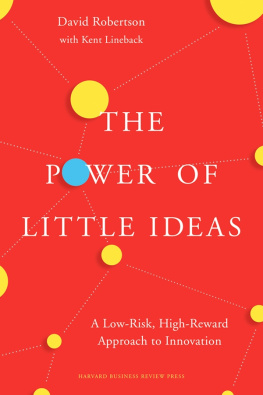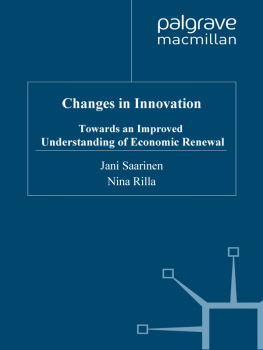NO-EXCUSES INNOVATION
STRATEGIES FOR SMALL- AND MEDIUM-SIZED MATURE ENTERPRISES
BRUCE A. VOJAK AND WALTER B. HERBST
STANFORD BUSINESS BOOKS
An Imprint of Stanford University Press
Stanford, California
Stanford University Press
Stanford, California
2022 by the Board of Trustees of the Leland Stanford Junior University.
All rights reserved.
No part of this book may be reproduced or transmitted in any form or by any means, electronic or mechanical, including photocopying and recording, or in any information storage or retrieval system without the prior written permission of Stanford University Press.
Special discounts for bulk quantities of Stanford Business Books are available to corporations, professional associations, and other organizations. For details and discount information, contact the special sales department of Stanford University Press. Tel: (650) 725-0820, Fax: (650) 725-3457
Printed in the United States of America on acid-free, archival-quality paper
Library of Congress Cataloging-in-Publication Data
Names: Vojak, Bruce A., author. | Herbst, Walter B., author.
Title: No-excuses innovation : strategies for small- and medium-sized mature enterprises / Bruce A. Vojak and Walter B. Herbst.
Description: Stanford, California : Stanford Business Books, an imprint of Stanford University Press, 2022. | Includes bibliographical references and index.
Identifiers: LCCN 2021061491 (print) | LCCN 2021061492 (ebook) | ISBN 9781503627581 (cloth) | ISBN 9781503633469 (ebook)
Subjects: LCSH: Small businessTechnological innovations. | Small businessManagement.
Classification: LCC HD2341 .V65 2022 (print) | LCC HD2341 (ebook) | DDC 338.6/42dc23/eng/20211227
LC record available at https://lccn.loc.gov/2021061491
LC ebook record available at https://lccn.loc.gov/2021061492
Cover design: Tandem Design
Cover image: Ceramic bladed box cutter for Slice by Herbst Produkt
To my late parents, Edward and Arlene Vojak, for teaching methrough both word and deedgratitude for and to those who create and sustain jobs; and to my wife, Ingrid Jansch, for the understanding, acceptance, peace, and joy she brings to my life. S.D.G.Bruce
To my son, Scot, and daughter, Annie, for always encouraging me and, more important, going along with my next adventure. For Scot, the brilliant industrial designer, who in spite of all my years in the field continues to teach me more on a daily basis.Walter
The future is purchased by the present.
Samuel Johnson
Contents
Preface and Acknowledgments
Everybody has a plan until they get punched in the mouth.
Mike Tyson, former undisputed world heavyweight boxing champion
Over the past decade, we have had the good fortune and pleasure to engage together on various innovation topics. Our complementary expertise, experiences, observations, perspectives, and personalities always have yielded fruitful discussions, providing even more for each of us to consider.
While various themes have ebbed and flowed, for some time now, the innovation needs of small- and medium-sized mature enterprises (SMMEs) have dominated our thinking. Both of us see the same pattern. A handful of SMMEs get it. They know what to do, embrace it, and make it happen. At the other end of the spectrum, many SMMEs dont get it. Whether consumed with or satisfied by current business, they are not inclined toward innovation and seemingly not convincible. And then there are those SMMEslikely appearing at least as often as those that get ittouting innovation capability with expertise that is nowhere to be found.
At some level, we could easily walk away from all this. Yet we are concerned. SMMEs play a significant role in total employment and thus a substantial role in local, regional, and national economies. When SMMEs succeed by their innovativeness or are brought down by that of othersmetaphorically punching or getting punched in the mouth la Mike Tysonit has an impact on the lives of individuals and the survival of firms. And when SMMEs flourish, falter, or fail, localities and regions often follow suit.
What makes the situation more challenging for SMMEs is that they are relatively neglected in the innovation literature. Further, it is difficult enough for large and mature companies executives, innovation managers, and innovation practitioners to keep up with the countless innovation blogs, podcasts, articles, and books released annually. Imagine now the broader and often more urgent set of responsibilities typically carried by their SMME counterparts. Without clear and straightforward means to bring those in SMMEs up to speed and make them conversant on innovation as an investment opportunity, innovation often gets ignored.
Our motivation, then, is two-fold: to help SMMEstheir owners, boards, CEOs, executive leaders, and employeessurvive and thrive in business and, as a result, to support local, regional, and national economies. We believe that SMMEs, and thus economies, can flourish over time if they practice innovation and do so wisely.
WHAT WE MEAN BY AN SMME
So what do we mean by a mature company? We begin by recognizing that all companies are on an S-curve (see ). At some point, every company, product, service, or business model that survives will, in looking in the mirror, hit an inflection point (B) in growth and, without intervention, eventually reach maturity (C). Yet since companies only recognize this inflection point and maturity in hindsight, they will not realize that they have reached them until it is too late. Therefore, we address our book to all small- and medium-sized companies that have moved beyond the emergence phase (A).
Then what do we mean by small- and medium-sized enterprises? We take a broad view for industrialized economies, including businesses with annual revenue up to several hundred million dollars. We readily acknowledge that this definition is not very specific. For example, it does not address potential questions about whether these are privately held or public companies or whether a founder or later-generation family member runs the company. We are not overly concerned with such distinctions. Our message is more holistic, pertinent to all companies in this size range since their unique challenges are more fundamental than these differences.

FIGURE P.1. The three primary S-curve phases.
In contrast to large companies, SMMEs are on their own to win or lose in the marketplace. They may lack the relative economies of scale and scope, available to large companies, to understand and invest in innovation. Often they are in a position of sustained disadvantage with no perceived path of renewal. A significant number of these companies focus more on optimizing existing business rather than renewal. Many are milking their business, even if they do not explicitly acknowledge it. Without attending to renewal, even SMMEs in a current position of competitive advantage will eventually fail.
As a potentially unexpected example to illustrate our definitions breadth and the opportunity innovation provides, consider the Oakland Athletics baseball team. This franchise reported total annual revenue of $225 million in 2019. team and its success offer an initial glimpse of the type of potential we seek to share with SMMEs.








